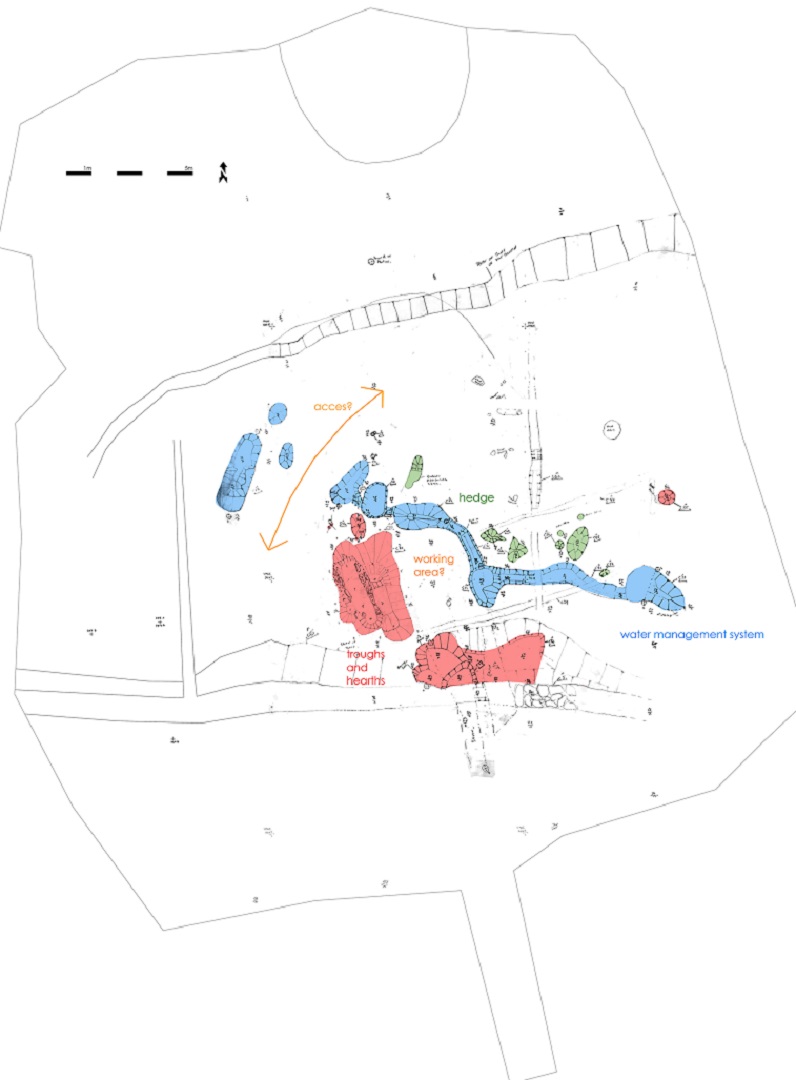County: Mayo Site name: Knockaphunta, Castlebar
Sites and Monuments Record No.: N/A Licence number: 16E0445
Author: Steven McGlade
Site type: Fulacht fiadh
Period/Dating: —
ITM: E 513837m, N 789214m
Latitude, Longitude (decimal degrees): 53.845250, -9.309365

The archaeological excavation of a fulacht fiadh site was carried out on the site of the proposed Castlebar Palliative Care Centre at Knockaphunta, Castlebar from 12-23 September 2016. The site was previously tested under Licence No. 15E219, Excavations Ref. 2015:331.
The site uncovered at Knockaphunta consisted of four fulacht fiadh troughs in two pairs, one of which was partially stone-lined, and was situated on the southern slope of a low drumlin. A second may also have been partially stone-lined, however post-medieval truncation had disturbed the possible lining. The earliest of the troughs (C70) was dated to the Middle Bronze Age with a radiocarbon date from the basal fill of 1704-1607BC. This was subsequently truncated and replaced by the partially stone-lined trough (C73), with a radiocarbon date of 1614-1493BC from the basal fill.
To the south of this a second pair of troughs was uncovered with the basal fill of the earliest of the troughs (C7) having a radiocarbon date of 1317-1051BC, in the Middle to Late Bronze Age. This represents a gap in the use of the pairs of troughs, possibly suggesting the first pair had been abandoned some centuries before the site was returned to and reused, with a further two troughs being excavated. Further activity was also present on the site with a large shallow pit later cutting both of the later troughs.
A series of interconnecting pits and channels relating to a water management system associated with the fulacht fiadh, a number of possible hearths, and evidence of a former hedgerow were also uncovered during the excavation. The associated spread of burnt stone and charcoal was found to be heavily disturbed.
A low-lying area to the south of the fulacht fiadh, occupied by a wide backfilled field boundary ditch, was originally a marshy or boggy tract of land between the low drumlin in the north of the development site on which the fulacht fiadh was located, and a second to the south-west.
The associated spread of burnt stone and charcoal was found to have been heavily disturbed during the 19th and 20th centuries, with early modern ceramics and glass apparent throughout. The field boundary to the south was depicted on the 1830s OS map, and later agricultural and drainage features were identified during the excavation and testing programmes.
There is anecdotal evidence that the site was used as a dump during the 20th century, with waste material from St Mary’s Hospital being dumped on the site and subsequently used in local road surface works (Andy Neary pers. comm. 2016). Towards the end of the 20th century the site was part of a pitch and putt course.
The size of the burnt spread associated with the fulacht fiadh, combined with the presence of the water management system, suggest that the fulacht fiadh was used intensively. The environmental analysis of the western water management ditch indicated that it was lined with oak (O’Donnell 2017). The environmental analysis of the charcoal from one of the pits along the eastern water management system indicated a mixed environment, and suggests that closed canopy woodlands did not prevail in the vicinity of the site during the final use of the system (ibid.) Oak again predominated in this fill and there is a possibility that an oak lining had been present along this part of the water management system also, though it did not survive. It is likely that the water management system was in use during the use of both pairs of fulacht troughs. The charcoal analysis from the earlier troughs indicate tree species that would have grown in wetland environments and were not opposed to closed canopy woodlands, while the later trough fills contained some species that indicate a more open landscape, with ash present, which is very intolerant of shade (ibid.)
The preliminary report for the site can is available at from www.archaeologyplan.com/projects-3.
Aileach Archaeology, on behalf of Archaeology Plan, 32 Fitzwilliam Place, Dublin 2